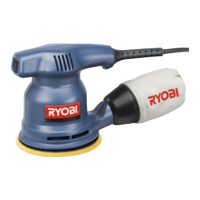
Do you have a question about the Ryobi RS241 and is the answer not in the manual?
| Type | Random Orbit Sander |
|---|---|
| Voltage | 120V |
| Dust Collection | Yes |
| Power Source | Corded |
| Pad Size | 5 inch |
| Weight | 3.0 lbs |
Explains safety symbols like Danger, Warning, and Caution used in the manual.
Details the concept of double insulation in electric power tools for user safety.
Comprehensive list of safety precautions for operating the sander safely and effectively.
Warns about hazardous dust from construction activities and its health effects.
Explains the simple switch control and the ergonomic palm grip for handling.
Describes how the conversion pad allows the use of velcro type sanding discs.
Explains the dual motion for fast cutting and good results.
Details the power supply requirements (120V, 60Hz AC) for the sander.
Lists the intended uses for the sander, such as wood sanding.
Details items included in the box and the importance of inspecting for damage.
Step-by-step guide on how to apply pressure-sensitive adhesive sanding discs.
Provides advice on choosing the correct grit for different sanding tasks and finishes.
Explains why discs should be removed after use to prevent adhesive issues.
Guides on using the conversion pad and attaching velcro-type sanding discs.
Details the function and installation of the dust bag assembly.
Instructions on how to connect the sander to a vacuum for dust collection.
Advice on selecting and using appropriate extension cords for the sander.
Consolidates warnings about clothing, switch position, and product misuse.
Basic preparation steps, including securing the workpiece and avoiding air vents.
Details on how to sand, pressure, overheating, and flush sanding.
Lists available accessories like different grit sanding discs and conversion pads.
Instructions for cleaning and emptying the dust bag assembly, including fire warnings.
Guidance on cleaning plastic parts and avoiding damaging solvents.
Information on the tool's lubrication, stating no further lubrication is needed.
A chart detailing recommended wire gauge for extension cords based on tool ampere rating and length.
How to contact Ryobi for repair parts or service.
Instructions on where to find the tool's model and serial numbers.
